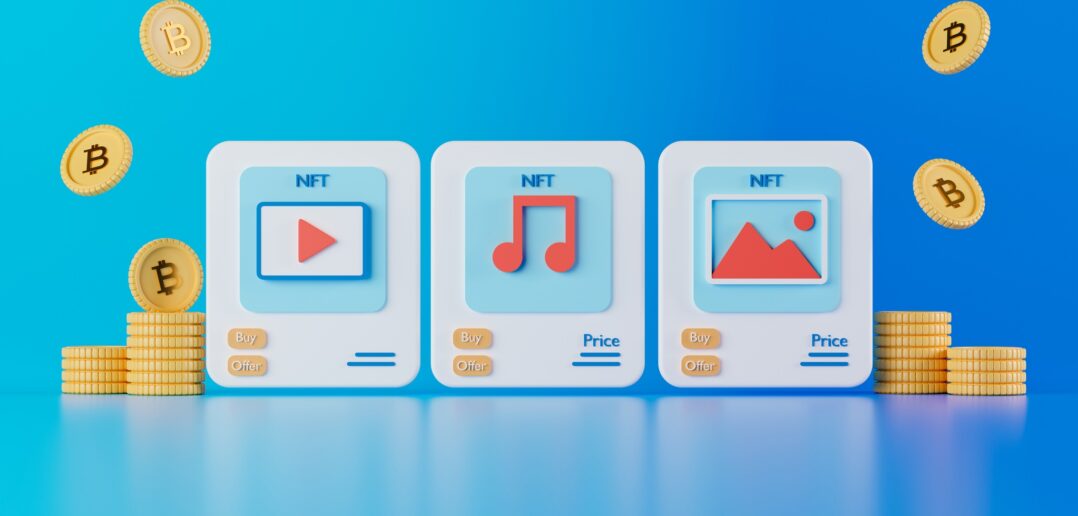Non-fungible tokens (NFTs) and the entertainment industry
Beginning of March 2021, Ben Mauro, a concept artist who worked on the Hobbit films, Man of Steel, and the upcoming Halo Infinite video game, made more money in seven minutes than he has in twelve years of working in the entertainment industry. That’s when he sold a dozen pieces of his digital art for $2 million, each authenticated with unique codes called NFTs.
NFTs innovation
NFTs, or non-fungible tokens, are blockchain-based tokens that prove ownership of a piece of digital imagery. NFTs use the same type of tech that underpins cryptocurrencies to verify the authenticity of other digital assets, potentially making a collectible out of a JPEG, a GIF or even a tweet.
Shortly after Mauro’s deal, NFTs exploded into the mainstream, when a collection by digital artist Beeple sold for $69 million in a Christie’s auction. And now, many who make their living in Hollywood are seeking to capitalize on an innovation some consider as significant for visual media as the founding of Napster was for digital music.
From IPs protection to social experience with fans
Multiple studios are exploring their own licensed marketplaces for NFTs, but they’re also grappling with how to protect their intellectual property, as a former DC artist recently made nearly $2 million selling Wonder Woman NFTs.
Lionsgate has signed a strategic partnership with Autograph, the NFT platform co-founded by Tom Brady to work on NFTs of entertainment franchises, such as The Hunger Games, Mad Men, John Wick, and Dirty Dancing.
Fox Entertainment is putting $100 million behind its NFT project, which will initially be driven by a show called Krapopolis from Rick and Morty creator Dan Harmon. It will feature blockchain-related content “from character development right up through premiere night in 2022.”
A “dedicated marketplace” for the show will “curate and sell digital goods, ranging from NFTs of one-of-a-kind character and background art and GIFs, as well as tokens that provide exclusive social experiences to engage and reward super fans,” Fox said in a press release. Fox is also launching Blockchain Creative Labs with animation studio Bento Box Entertainment.
Even CNN is getting into the game, selling NFTs of some iconic moments from the cable news channel’s history called “Vault by CNN.” In a FAQ about the service, CNN explains the rationale to launch the “Vault”:
“Until now, there has been no way to ‘collect’ these moments. Users can often find old footage online, or packaged up in documentaries, but they cannot ‘own’ them or display them in the way they can with a print newspaper or magazine.”
Could the entertainment industry be shaken up again, this time by the emergence of NFTs, to revive fan economies and the market for special edition products and collectibles? NFTs can help redefine the relationship between artists and their fans. And the examples mentioned here show the potential of NFTs for owners of intellectual property, who can partner with tech platforms like Autograph to develop their existing IP into NFTs.
But as a collector what do you do with your NFTs after you bought them? How can you showcase them?
NFTs getting mainstream ?
Social Media giants such as TikTok and Twitter are starting to embrace NFTs, too, which could make them more mainstream. TikTok has announced its own NFT drop, leveraging content from some of its top creators, such as Lil Nas X, Bella Poarch, Curtis Roach and others. A NFT drop is where companies create collectible art or other items tied to an intellectual property and put them on the blockchain for fans to buy, trade, and sell.
Meanwhile, Twitter is experimenting with NFTs to allow users to display their collections as their profile pictures. According to Mada Aflak, a senior software engineer at Twitter, the microblogging platform is working on a new functionality that will let users import their NFT collections from their wallets on the blockchain. The feature would display a verified checkmark based on the blockchain the NFT has been minted on. Because without any kind of verification process, someone else’s NFTs can easily be reused on social media. Showing off NFTs and verifying ownership could soon be part of a new reputation system on the web.
NFT strategies in the content space
Some NFT strategies in the content space are also going beyond the standard NFT drop. Wolf Entertainment’s, the TV and media empire behind such franchises as Law & Order and its trio of Chicago series (Chicago Fire, Chicago Med, and Chicago P.D.), has been looking for ways to expand into new media and connect with fans on platforms beyond their TV screens. The result is the Wolf Society, a “membership-based society for online detectives,” Wolf says, which will launch at the end of November. The site will be accessible on Curio, an NFT marketplace that’s built on the Ethereum blockchain.
In the case of Wolf Society, members will have the ability to purchase NFTs that contain clues to a cold case they can work to solve. Each limited-edition NFT will reveal written, audio, and/or video clues about the case. Wolf Society members can then trade, buy, and sell the NFTs with other members to obtain more clues.
This is an exciting and quickly evolving area for IP owners and crypto enthusiasts, as well as another steppingstone to the metaverse.
TV Trends in your inbox? Fill in your details to subscribe to the MIP Newsletter →
For more information on TV Trends, attend MIPCOM and MIPTV
You can read also :
What do television brands and properties need to do to be metaverse-ready?
Metaverse & the Future of TV Industry
Tweens : The overlooked generation




